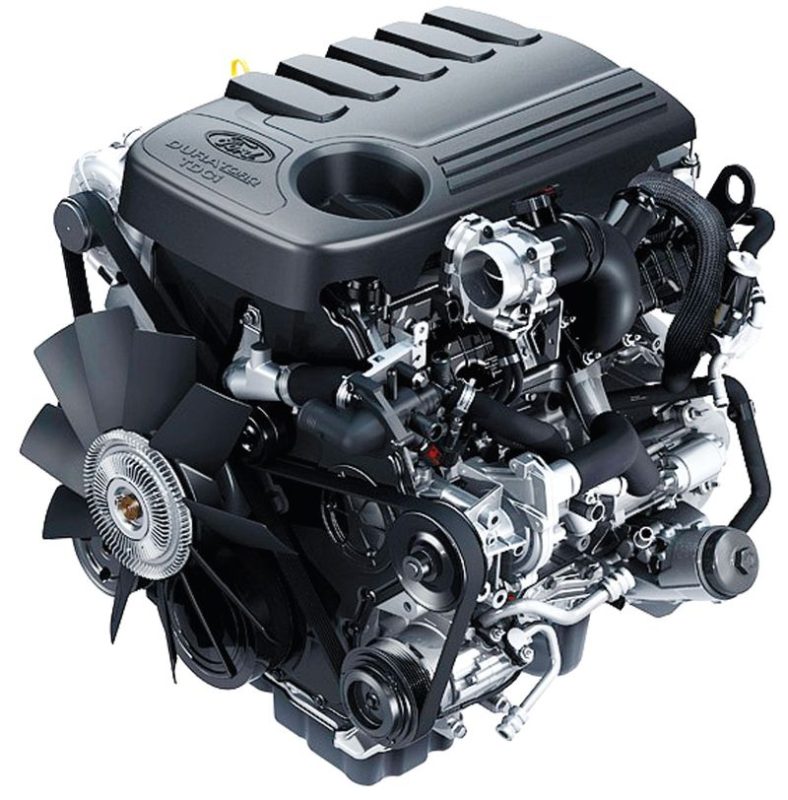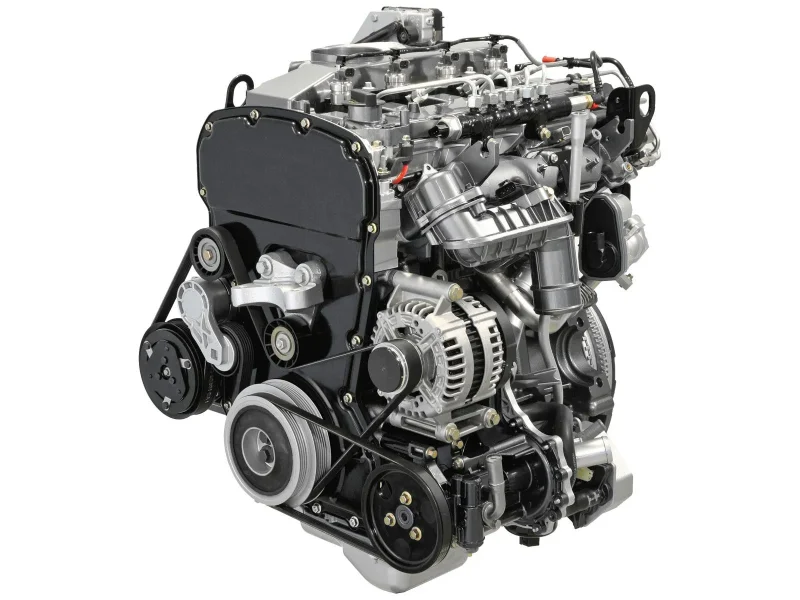The Ford 2.2 TDCi diesel engines, manufactured from 2006 to 2018, have become widely popular due to their reliability and efficiency. These engines were installed on various models of Ford, Land Rover and Jaguar cars. The basis for their development was the Peugeot DW12MTED4 and DW12CTED4 diesel units, which explains the similarity of design solutions and technical characteristics.
History and development
The Ford 2.2-liter 2.2 TDCi diesel engine made its debut in the 2006 Land Rover Freelander II SUV. This engine was a variation of the Peugeot DW12MTED4 motor and had an output of 156 hp. In 2008, a 175-horsepower modification appeared, which was installed on Ford Mondeo, Galaxy and S-Max models.
The engine is based on a cast iron cylinder block and aluminum 16-valve cylinder head with hydrocompensators. The timing drive is made on a combined scheme: belt and chain connect the camshafts. Common Rail fuel system developed by Bosch (EDC16CP39) with piezo nozzles provides high efficiency of fuel injection. The Garrett GTB1752VK variable geometry turbocharger and intercooler are also important components of this system.
In 2010, the engine was modernized, which increased its output to 200 hp. A new Mitsubishi TD04V turbine was responsible for this, which provided a higher level of supercharging.
Modifications and technical characteristics
First Generation
The first generation Ford 2.2 TDCi engine developed 175 hp and was equipped with a Garrett GTB1752VK turbine:
- Type: in-line
- Number of cylinders: 4
- Number of valves: 16
- Volume: 2179 cm³
- Cylinder bore: 85 mm
- Piston stroke: 96 mm
- Power system: Common Rail
- Power: 175 hp
- Torque: 400 Nm
- Compression ratio: 16.6
- Fuel: diesel
- Environmental standards: EURO 4
Two versions of this engine were offered for Ford models:
- Q4BA (175 hp / 400 Nm): Ford Mondeo Mk4
- Q4WA (175 hp / 400 Nm): Ford Galaxy Mk2, S-Max Mk1
Engine options for Land Rover
A less powerful version has been developed for Land Rover SUVs:
- Type: in-line
- Number of cylinders: 4
- Number of valves: 16
- Volume: 2179 cm³
- Cylinder bore: 85 mm
- Piston stroke: 96 mm
- Power system: Common Rail
- Power: 152 – 160 hp
- Torque: 400 – 420 Nm
- Compression ratio: 16.5
- Fuel: diesel
- Environmental standards: EURO 4/5
Only engine version:
- 224DT (152 – 160 hp / 400 Nm): Land Rover Evoque I, Freelander II
Second generation
The second generation of engines developed up to 200 hp thanks to the MHI TD04V turbine:
- Type: in-line
- Number of cylinders: 4
- Number of valves: 16
- Volume: 2179 cm³
- Cylinder bore: 85 mm
- Piston stroke: 96 mm
- Power system: Common Rail
- Power: 200 hp
- Torque: 420 Nm
- Compression ratio: 15.8
- Fuel: diesel
- Environmental standards: EURO 5
Engine variants for Ford
The following versions existed for Ford models:
- KNBA (200 hp / 420 Nm): Ford Mondeo Mk4
- KNWA (200 hp / 420 Nm): Ford Galaxy Mk2, S-Max Mk1
Engine options for Land Rover
A 190 hp version was available for Land Rover SUVs:
- Type: in-line
- Number of cylinders: 4
- Number of valves: 16
- Volume: 2179 cm³
- Cylinder bore: 85 mm
- Piston stroke: 96 mm
- Power system: Common Rail
- Power: 190 hp
- Torque: 420 Nm
- Compression ratio: 15.8
- Fuel: diesel
- Environmental standards: EURO 5

Only engine version:
- 224DT (190 hp / 420 Nm): Land Rover Evoque I, Freelander II
Engine variants for Jaguar
Engine versions with different power outputs were available for Jaguar vehicles:
- Type: in-line
- Number of cylinders: 4
- Number of valves: 16
- Volume: 2179 cm³
- Cylinder bore: 85 mm
- Piston stroke: 96 mm
- Power system: Common Rail
- Power: 163 – 200 hp
- Torque: 400 – 450 Nm
- Compression ratio: 15.8
- Fuel: diesel
- Environmental standards: EURO 5
These engines had the same index as the Land Rover versions:
- 224DT (163 – 200 hp / 400 – 450 Nm): Jaguar XF X250
Problems and breakdowns of 2.2 TDCi engines
Main Problems
Like many modern diesels, Ford 2.2 TDCi engines suffer from a number of common problems:
- The piezo injectors are sensitive to fuel quality, which can cause them to fail prematurely.
- The EGR valve is prone to clogging, which can lead to decreased performance and increased emissions.
- The diesel particulate filter (DPF) has a limited life, especially when the vehicle is used in urban areas.
- The variable geometry turbocharger can lose efficiency due to soot buildup.
Liner rotation
This engine is also susceptible to liner rot if poor quality oils are used or if the engine is operated heavily at low speeds. Oils with viscosity of 5W-40 and 5W-50 are recommended.
Pros and cons of the Ford Transit 2.2 TDCi motor
In the two-thousandth year, the production of power units of the Puma (Duratorq) family began. These engines we have already dismantled, we have told in detail about the power units of Ford Mondeo 3rd generation and for Ford Transit. The engines were produced in Germany, they are in no way related to motors from PSA concern.
Puma diesels are not installed in Ford cars since 2006, but their use in commercial Fords still continues. Also diesel engines from Germany were received by Peugeot Boxer, Citroen Jumper, Fiat Ducato with designation 4H and P22DTE in the catalog. These engines have been constantly improved: over time they received Common Rail fuel system, there have been changes in the cylinder head (the design of the valve train has changed), since 2012 the engines have received a gate-type oil pump.
Turbocharger features
Motors Ford Puma (Duratorq) received a turbocharger Garrett GTA1749VK with variable geometry and electronic servo drive. Some engine models use a Mitsubishi TD03 turbine with a bypass flap, mostly power units of 2006-2007 model years received it.
Servo drive in the turbine is unreliable: it is characterized by rapid wear of gears and their failure. Breakdowns also occur in the electric motor, the reason is cracked contacts on the board.
Is the EGR valve reliable?
No. Engineers even recalled it, as the potentiometer of the position sensor broke in it, which was signaled:
- loss of thrust;
- black smoke.
And even the valve that was provided for replacement has problems: after 200,000 kilometers, it needs to be replaced. The cost of replacement valves from China – about a hundred dollars, used valves – cheaper.
The peculiarities of the TNVD
In motors where there is Common Rail, a Denso HP3 fuel injector is used. It is reliable, serves for a long time, creates a pressure of 1,800 bar. But at the same time, the pump is very demanding to the quality of fuel. It is necessary to use the original filter in the fuel injector, otherwise it quickly becomes dirty.
It is important to follow the engineers’ instructions on how to fill the filter with fuel – only through the inlet fitting on the filter bracket, using a hand pump. If you neglect this and fill it with fuel before installing it on its bracket, the fuel will not be filtered.
The boost section of the fuel injector is a let down: if poor quality fuel is used, over time the rotary trochoid pump will begin to chip, and although it turns out to be small, it is enough to wear out the spool and flow control valve body.
If at regular replacement of filters the valve service life is only 100-150 thousand kilometers, then the fuel injector must be repaired: most likely, the cause is in the breakdown of the elements of the pump pump.
When does the flow control valve require replacement?
The flow control valve is a linear solenoid that moves the needle valve and is responsible for the fuel flow and its pressure level in the ramp.
Floating rpm is a sign that there is a problem with the valve. The cost of the valve is about a hundred dollars. You can also buy a non-original, but they are characterized by such malfunctions as a small resource and a low-quality chip.

If there is no desire to purchase a replacement valve, you can use a folk method – disassemble the device and polish the scratches.
Installing the valve, you need to be careful, otherwise you can damage the valve’s sealing ring, which will lead to fuel leaks. With the adaptation of the valve on Fords will help:
- Chinese OBD scanner;
- ForScan application (unofficial).
Pros and cons of Denso injectors
A common and the only problem with Denso injectors type G2 (DCRI105800) in the Puma (Duratorq) motor is significant amounts of fuel drained into the return. This fault is signaled by:
- problems with starting the engine;
- stalling engine under load.
The cause of fuel drainage is wear of the passage valve, on the surface of which small grooves appear: they appear if cheap fuel is used. The problem is solved by replacing the valve, but it is also necessary to check the condition of the injector stem – they may be worn out. A microscope will be needed for checking, without it the wear will not be visible.
New injectors will cost almost two hundred dollars, used – cheaper. For installation, new copper washers will be needed, it is also necessary to prescribe the device.
Life span of the timing chain
Replacement of the single-row timing chain, which is used in the power units of Ford Duratorq (Puma), will be needed after 200 thousand kilometers of mileage. The chain rarely overshoots, and more often on 2.4-liter motors than on 2.2-liter motors, the reason is in the more reliable design of the engines.
Weak elements of the cylinder-head assembly
The hydrocompensators in the cylinder head fail – their service life is only 200 thousand kilometers. After the failure of one hydrocompensator, a muffled knock is heard, and the intake manifold pulsation is noticeable in the intake pipe. Ignore the problem can not be ignored, otherwise the “jumping” rocker will lie on its side and fall off. This is not the worst case: sometimes it falls under the camshaft cam, there are also known cases of rocker breaking in half.
The “rumbling” engine needs to be repaired by changing the entire rocker frame. The cost of the frame and rockers is about three hundred dollars. It is recommended to regularly (every 200 thousand kilometers) check the condition of hydrocompensators, in the presence of sagging to change the frame.
What kind of oil pump is used in the engines?
In the Puma engine models produced before 2011, a gear-type oil pump was installed, with which there were no problems. But after 2011, when the engines became more environmentally friendly and got a slide-type pump, problems began: its slide vanes easily broke off, causing a rapid drop in lubrication pressure and oil starvation. Failures led to problems with the cylinder head, turbine, and if the problems were ignored, the engine even jammed because of the liners welded to the crankshaft journals.
Breakage of blades happens after 40-60 thousand kilometers of mileage. To get rid of this malfunction, it is recommended to install an old, gear pump instead of the gate pump. There will be no problems with installation.
Why are the oil injectors clogged?
The reason is dirty oil and its decreased pressure. Clogged oil injectors cause the piston to overheat, crack or expand, scoring the cylinder walls.
Conclusion
Ford 2.2 TDCi diesel engines have proven to be successful and popular due to their power and economy. Despite some problems, they have earned recognition among motorists and continue to be used in many vehicles. The 200,000 km service life of these engines is often exceeded, reaching up to 300,000 km with proper operation and maintenance.
